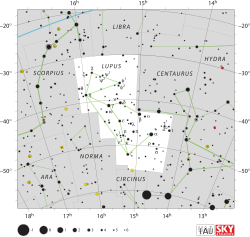|
| Ny1 Lupi (ν1) |  | Observationsdata
Epok: J2000 |
|---|
| Stjärnbild | Vargen |
|---|
| Rektascension | 15t 22m 08,27124s[1] |
|---|
| Deklination | -47° 55′ 40,0543″[1] |
|---|
Skenbar magnitud ( ) ) | 5,01[2] |
|---|
| Stjärntyp |
|---|
| Spektraltyp | F6 III-IV[3] |
|---|
| U–B | +0,04[2] |
|---|
| B–V | +0,50[2] |
|---|
| Astrometri |
|---|
Radialhastighet ( ) ) | -11,90 ± 0,30[4] km/s |
|---|
| Egenrörelse (µ) | RA: -141,19[1] mas/år
Dek.: -132,92[1] mas/år |
|---|
Parallax ( ) ) | 27,89 ± 0,33[1] |
|---|
| Avstånd | 117 ± 1 lå (35,9 ± 0,4 pc) |
|---|
Absolut magnitud ( ) ) | +2,32[5] |
|---|
| Detaljer |
|---|
| Massa | 1,67[6] M☉ |
|---|
| Radie | 2,87[4] R☉ |
|---|
| Luminositet | 11,26[4] L☉ |
|---|
| Temperatur | 6 447 ± 80[6] K |
|---|
| Metallicitet | 0,17 ± 0,05[6] |
|---|
| Vinkelhastighet | 2,8 ± 0,2[5] km/s |
|---|
| Ålder | 2,0 ± [5] miljarder år |
|---|
| Andra beteckningar |
|---|
| ν1 Lup, CD-47° 9922, FK5 3211, HD 136351, HIP 75206, HR 5698, SAO 225703. [7] |
Ny1 Lupi (ν1 Lupi, förkortad Ny1 Lup, ν1 Lup), som är stjärnans Bayer-beteckning, är en ensam stjärna[8] i mellersta delen av stjärnbilden Vargen. Den har en magnitud av 5,01[2] och är synlig för blotta ögat där ljusföroreningar ej förekommer. Baserat på parallaxmätning inom Hipparcosuppdraget på ca 27,9 mas,[1] beräknas den befinna sig på ett avstånd av ca 117 ljusår (36 parsek) från solen.
Egenskaper
Ny1 Lupi är en gul till vit underjättestjärna av spektralklass F6 III-IV,[3] som anger att spektret har egenskaper som ligger mellan en underjätte och jättestjärna. Den har en massa som är ca 70 procent[6] större än solens massa, en radie som är ca 2,9[4] gånger solens radie och avger ca 11[4] gånger mer energi än solen från dess fotosfär vid en effektiv temperatur på ca 6 400 K.[6]
Ny1 Lupi är troligtvis källa till den röntgenstrålning[9] med en styrka på 1,09 × 1029 erg/s, som observeras vid dess koordinater.[10]
Referenser
- Den här artikeln är helt eller delvis baserad på material från engelskspråkiga Wikipedia, 4 februari 2019.
Noter
- ^ [a b c d e f] van Leeuwen, F. (2007), "Validation of the new Hipparcos reduction", Astronomy and Astrophysics, 474 (2): 653–664, arXiv:0708.1752, Bibcode:2007A&A...474..653V, doi:10.1051/0004-6361:20078357.
- ^ [a b c d] Mermilliod, J.-C. (1986), "Compilation of Eggen's UBV data, transformed to UBV (unpublished)", Catalogue of Eggen's UBV data, SIMBAD, Bibcode:1986EgUBV........0M.
- ^ [a b] Gray, R. O.; et al. (2006), "Contributions to the Nearby Stars (NStars) Project: spectroscopy of stars earlier than M0 within 40 pc-The Southern Sample", The Astronomical Journal, 132 (1): 161–70, arXiv:astro-ph/0603770, Bibcode:2006AJ....132..161G, doi:10.1086/504637.
- ^ [a b c d e] https://www.universeguide.com/star/nu1lupi. Hämtad 2019-02-04.
- ^ [a b c] Ammler-von Eiff, M.; Reiners, A. (June 2012), "New measurements of rotation and differential rotation in A-F stars: are there two populations of differentially rotating stars?", Astronomy & Astrophysics, 542: 31, arXiv:1204.2459, Bibcode:2012A&A...542A.116A, doi:10.1051/0004-6361/201118724, A116.
- ^ [a b c d e] Bensby, T.; et al. (2014), "Exploring the Milky Way stellar disk. A detailed elemental abundance study of 714 F and G dwarf stars in the solar neighbourhood", Astronomy & Astrophysics, 562 (A71): 28, arXiv:1309.2631, Bibcode:2014A&A...562A..71B, doi:10.1051/0004-6361/201322631.
- ^ "* nu.01 Lup". SIMBAD. Centre de données astronomiques de Strasbourg. Hämtad 2017-03-08.
- ^ Eggleton, P. P.; Tokovinin, A. A. (September 2008), "A catalogue of multiplicity among bright stellar systems", Monthly Notices of the Royal Astronomical Society, 389 (2): 869–879, arXiv:0806.2878, Bibcode:2008MNRAS.389..869E, doi:10.1111/j.1365-2966.2008.13596.x.
- ^ Haakonsen, Christian Bernt; Rutledge, Robert E. (September 2009), "XID II: Statistical Cross-Association of ROSAT Bright Source Catalog X-ray Sources with 2MASS Point Source Catalog Near-Infrared Sources", The Astrophysical Journal Supplement, 184 (1): 138–151, arXiv:0910.3229, Bibcode:2009ApJS..184..138H, doi:10.1088/0067-0049/184/1/138.
- ^ Pizzolato, N.; et al. (September 2000), "Evolution of X-ray activity of 1-3 Msun late-type stars in early post-main-sequence phases", Astronomy and Astrophysics, 361: 614–628, Bibcode:2000A&A...361..614P.
Externa länkar
|





